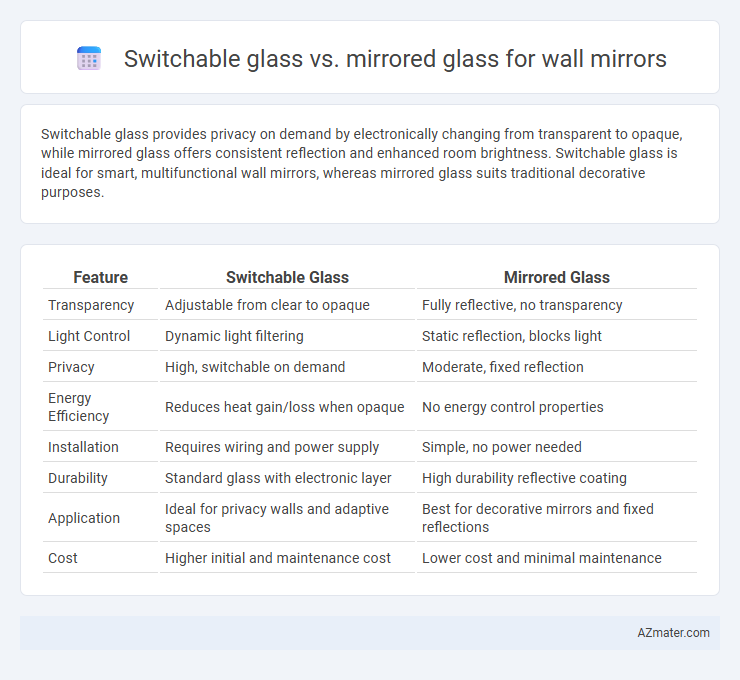Switchable glass provides privacy on demand by electronically changing from transparent to opaque, while mirrored glass offers consistent reflection and enhanced room brightness. Switchable glass is ideal for smart, multifunctional wall mirrors, whereas mirrored glass suits traditional decorative purposes.
Table of Comparison
| Feature | Switchable Glass | Mirrored Glass |
|---|---|---|
| Transparency | Adjustable from clear to opaque | Fully reflective, no transparency |
| Light Control | Dynamic light filtering | Static reflection, blocks light |
| Privacy | High, switchable on demand | Moderate, fixed reflection |
| Energy Efficiency | Reduces heat gain/loss when opaque | No energy control properties |
| Installation | Requires wiring and power supply | Simple, no power needed |
| Durability | Standard glass with electronic layer | High durability reflective coating |
| Application | Ideal for privacy walls and adaptive spaces | Best for decorative mirrors and fixed reflections |
| Cost | Higher initial and maintenance cost | Lower cost and minimal maintenance |
Introduction to Switchable and Mirrored Glass
Switchable glass, also known as smart glass, allows instant toggling between transparent and opaque states using an electric current, offering privacy and modern design flexibility. Mirrored glass provides a reflective surface that enhances room brightness and creates the illusion of more space, commonly used for decorative and functional wall mirrors. Both materials serve distinct purposes in interior design, with switchable glass emphasizing dynamic privacy and mirrored glass focusing on reflection and aesthetics.
How Switchable Glass Works
Switchable glass uses liquid crystal technology embedded between two glass panes, allowing it to change from opaque to transparent when an electrical current is applied, offering privacy and light control in wall mirrors. Mirrored glass, by contrast, provides a reflective surface by coating one side with a metal layer, without the ability to change transparency or opacity. The key advantage of switchable glass lies in its dynamic functionality, enabling users to switch the mirror's visibility on demand, unlike static mirrored glass.
Understanding Traditional Mirrored Glass
Traditional mirrored glass features a silver or aluminum backing that reflects light to create clear, high-quality images, making it ideal for wall mirrors in homes and commercial spaces. It provides consistent reflectivity and durability but lacks the dynamic privacy and light control offered by switchable glass technology. While mirrored glass excels in clarity and aesthetic appeal, it offers no electrical functionality, limiting its versatility compared to switchable glass.
Aesthetic Differences: Switchable vs Mirrored Glass
Switchable glass offers a sleek, modern aesthetic by transforming from transparent to opaque, allowing dynamic light control and privacy, ideal for contemporary wall mirror designs. Mirrored glass provides a classic, reflective surface with high visual clarity and brightness, enhancing room depth but without light modulation capabilities. The choice between switchable and mirrored glass hinges on the desired balance between functionality and aesthetic impact in interior spaces.
Privacy Features and Applications
Switchable glass offers dynamic privacy control by transitioning from transparent to opaque with an electrical signal, ideal for adaptable environments such as conference rooms and modern bathrooms. Mirrored glass provides constant privacy by reflecting light and obscuring visibility, making it suitable for decorative wall mirrors in bedrooms, living areas, or retail spaces. Both materials enhance privacy but differ in application flexibility, with switchable glass allowing on-demand privacy and mirrored glass ensuring permanent concealment.
Energy Efficiency and Light Control
Switchable glass offers superior energy efficiency by allowing users to adjust transparency, reducing heat gain and loss while optimizing natural light control in wall mirrors. Mirrored glass reflects light to enhance brightness but lacks dynamic lighting adjustment, potentially causing heat buildup and increased cooling costs. Integrating switchable glass in wall mirrors ensures adaptive light management and improved thermal regulation, leading to significant energy savings.
Durability and Maintenance Comparison
Switchable glass offers high durability with scratch-resistant coatings and robust electronic components designed for long-term use, making it less prone to physical damage compared to mirrored glass. Mirrored glass, while generally sturdy, can be more susceptible to surface scratches and requires regular polishing to maintain clarity and shine. Maintenance of switchable glass involves occasional electronic system checks and gentle cleaning, whereas mirrored glass demands frequent cleaning to prevent tarnishing and glass corrosion over time.
Cost Comparison: Upfront and Long-Term
Switchable glass wall mirrors generally have a higher upfront cost compared to mirrored glass due to advanced technology integration like embedded LCD or smart film. Mirrored glass remains more affordable initially and has lower maintenance expenses, making it cost-effective for traditional applications. Over the long term, switchable glass may offer energy savings and privacy benefits that could offset its initial price, but mirrored glass tends to have a better cost-to-benefit ratio for budget-conscious projects.
Installation Requirements and Flexibility
Switchable glass for wall mirrors requires integration with electrical wiring and a compatible power source for operation, making installation more complex than mirrored glass, which only needs standard mounting hardware. Mirrored glass offers greater flexibility in placement and design due to its simpler installation and lack of electrical components. Switchable glass provides dynamic opacity control, ideal for adaptable privacy or display features, but demands careful planning for electrical access and maintenance.
Best Use Cases: Which is Right for Your Wall Mirror?
Switchable glass offers privacy control and can transform from transparent to opaque, ideal for modern living spaces, conference rooms, and bathrooms where variable light and privacy are essential. Mirrored glass provides high reflectivity and aesthetic appeal, perfect for decorative wall mirrors in bedrooms, dressing areas, and gyms to enhance lighting and spatial perception. Choose switchable glass for functional versatility and mirrored glass for classic reflection and style in your wall mirror application.

Infographic: Switchable glass vs Mirrored glass for Wall mirror
 azmater.com
azmater.com